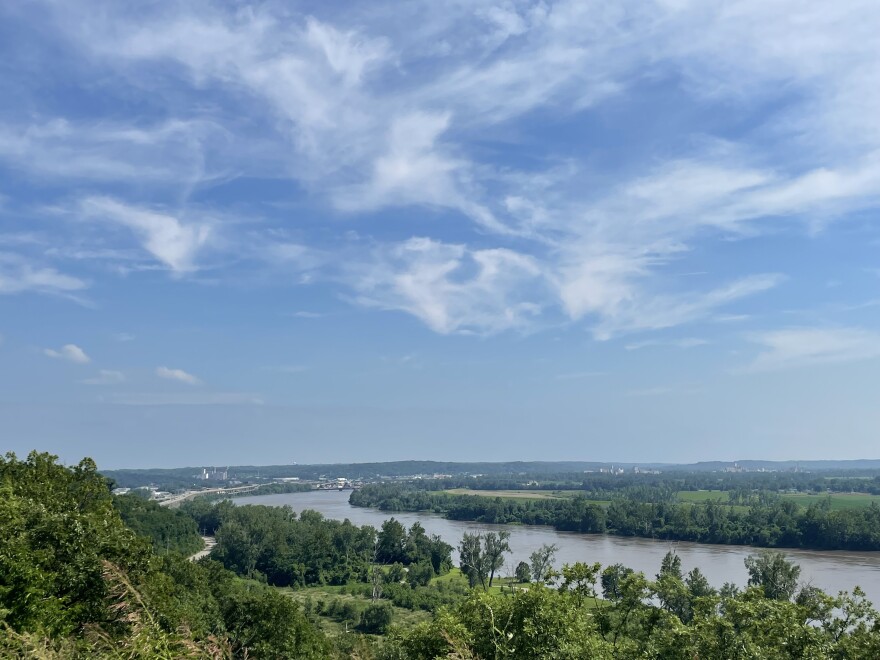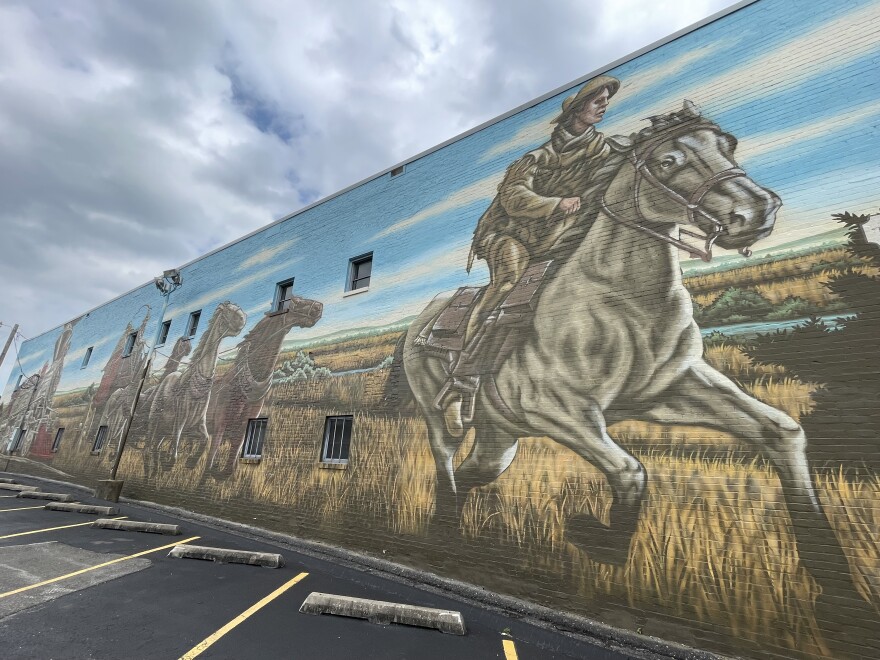This story was first published in KCUR's Adventure newsletter. You can sign up to receive stories like this in your inbox every Tuesday.
The river city of St. Joseph is about an hour’s drive north of Kansas City, straight up Highway 29. It’s the county seat for Buchanan County, and, like Kansas City, was founded by a French fur trader along the banks of the Missouri River.
Nicknamed “St. Joe,” the area was previously called the Blacksnake Hills, where Joseph Robidoux set up his trading post for the American Fur Company in 1826. He founded the town in 1843, attracting both settlers and those headed beyond.
As the western terminus for the pre-Civil War railroad, the city was considered the jumping off point for the Wild Wild West and the very edge of civilization.
Learn about the history and sites of Kansas City’s northern neighbor with this beginner’s guide to St. Joseph.
Treasuring history

St. Joseph celebrates its 19th century roots with historical sites, museums, and parks. Between riverboats, trains, and wagons, it was a busy commercial hub during that time period (in 1860, it had twice the population of Kansas City).
St. Joe grew quickly in the years following the Civil War, with the population nearly doubling each decade until 1900. The population has remained steady at 70-80,000 residents in the last century.
The St. Joseph Historical Society houses its headquarters in Robidoux Row, the oldest building in St. Joe and the oldest apartment building west of the Mississippi, just off St. Joseph Avenue. Robidoux built these one-room apartments in the early 1840s/late 1850s and lived there in the last years of his life. The building fell into disrepair and was condemned by the 1970s, but the historical society restored it into a museum and event space.
The Pony Express, which ran from April 1860 to October 1861, is a key factor in St. Joseph’s identity, with the silhouette of a rider seen on the city’s logo and around town. The Pony Express National Museum tells the story of this endeavor to speedily deliver mail to the West Coast. There is a lot to learn at this excellent museum about this short but crucial period in American history, with interactive exhibits, artifacts and recreations from the era.
Just down the street is the Patee House Museum, full of regional artifacts from the 19th century into the 1920s — including a carousel, train, and full size saloon bar. The building was at various times a luxury hotel, a women’s college and a garment factory. The Jesse James Home, where the outlaw James met his end in 1882, is also on the property.
The St. Joseph Museums, right off Frederick Street, house a handful of specialized collections, including the Glore Psychiatric Museum, established in 1967. The museum chronicles not only the history of “State Lunatic Asylum No. 2” (renamed St. Joseph State Hospital in 1899), but the history of mental illness treatment. Many of the displays were created by George Glore, starting in the 1960s.
The other collections include the Black Archives Museum, Doll Museum, a Cabinet of Curiosity, and the Archeology & Native American Galleries (which is set to reopen soon). The Wyeth-Tootle Mansion is also part of the museum collective, though it is located in the Museum Hill Historic District, at 11th and Charles.
Celebrating the arts

St. Joseph has a thriving fine arts scene, with concert series, public art, murals, theater, and a symphony orchestra.
In downtown St. Joe, Coleman Hawkins Park honors jazz legend Coleman Hawkins, born in 1904. The bandstand is the site for various festivals, including HawkFest, as well as concert series, like the weekly summer series Imagine Eleven (Sundays) and Sounds of Summer (Fridays). A bronze statue of Hawkins stands sentry at the park, forever playing the saxophone.
All around downtown is the Sculpture Walk, an annual public art event featuring work from artists all over the country. You can vote for your favorite at the ballot box in Felix Street Square until January 31. Each year, some of the sculptures become a permanent part of the city scene. (Traveling around, you may notice some unusual street names — Faraon, Jules, Francis, Felix, Edmond, Charles, Sylvanie, and Messanie — the names of Robidoux’s children.)
The beautiful Missouri Theater, built in 1927, is just around the block from the park and is the home of the Saint Joseph Symphony as well as Robidoux Resident Theater, now in its 45th season.
The Albrecht-Kemper Museum of Art is less than a mile from the St. Joseph Museums. It has a permanent collection, rotating exhibits, art classes for all ages, and special events throughout the year. The third Tuesday of each month, the museum is free from 5-7 p.m.
Additionally, St. Joseph is home to Missouri Western State University. The institution originated as a Junior College in 1915 (classes were first held in Central High School), became the four-year Missouri Western College in 1969, and Missouri Western State University in 2005. Their mascot is the griffon, designated in 1917, a “symbol of wisdom and guardian of buried treasure .” On campus, the Potter Art Gallery shows 3-6 exhibitions of contemporary work each year.
Culinarily, St. Joseph has a variety of options, from popular chain restaurants, quirky coffee shops, and local favorites, like The Cabbage Roll — a German deli — to the reservation-only fine dining at JC Wyatt House.
If you have a sweet tooth, try Cherry Mash candy, one of St. Joe’s claims to fame. Dr. George Washington Chase started making candies in St. Joseph in 1876, and his son Ernest invented Cherry Mash in 1918. The candy is manufactured by Chase Candy Co., still operating in the city.
Traditions and events

Like any city, there are annual events that celebrate what is unique about the area and bring together the community, as well as monthly First Saturdays gatherings downtown.
In the spring, enjoy the St. Patrick’s Day Parade along Frederick Ave (named for original city planner Frederick W. Smith) in March, the Apple Blossom Festival, the oldest apple blossom festival in the country, and the Bluffwoods Renaissance Festival at the Castle Bridge Events Center.
In the summer, try out the Ales West! craft beer festival, Juneteenth celebrations the third weekend in June, and the annual Pony Express Re-Ride.
You can also check out the St. Joseph Mustangs, part of the M.I.N.K. Collegiate Summer Baseball League. Since 2009, the Mustangs have won the league championship eight times, making them the most successful team in the league. The season caps off at the end of July. (Learn more about Kansas City-region minor league baseball with this KCUR Adventure.)
A big event in July is the Kansas City Chiefs’ training camp. There are some public practices (some of which require a ticket) during their stay at Missouri Western State University. This year’s Red Rally is July 27 at Civic Center Park, by City Hall.
Heading into fall, there’s the Jewels of St. Joseph Homes Tour (which often sells out early), the Bluegrass Battles Hunger Concert, PumpkinFest, the Haunted Harris-Kemper Walking Tour, and Sugarplum Festival, a holiday gift market.
If you like running, there’s the Outlaw Adventure 5K (through unimproved trails and obstacles), the St. Joseph, Missouri Marathon (a Boston Marathon qualifying race, now in its second year), and the Donut Dash, a family-friendly 5K that starts at Patee House, passes historical sites, and ends at Gold-N-Glaze Donuts & Coffee Shop.
In winter, the downtown is transformed into a holiday wonderland, with special events each Saturday, starting with the lighting ceremony. There’s also holiday light drives through Krug Park and Hyde Parks, and the Mayor’s Children’s Christmas Party the second Saturday in December at the Bode Ice Arena.
A regularly updated list of events is found on the Explore St. Joe website.
More to explore

With its proximity to the river, St. Joe connects closely with nature. The St. Joseph Parkways system was started in 1918, and connects major parks throughout its 26 miles for relaxing, walking, jogging, and biking. The summer series Parties in the Parkways hosts concerts in different locations around the city.
St. Joseph also has the Remington Nature Center, located on the banks of the Missouri to the north of downtown. The north trailhead for the St. Joseph Riverwalk is nearby, meandering along the river to the south trailhead that lets out under the highway 229 underpass (though the walk is sometimes closed due to flooding).
For mountain bike enthusiasts, you’ll find trails throughout the surrounding area, with a skills area and miles of trails connecting the Huston Wyeth Hill Scenic Overlook and River Bluff Trails Park.
The 165-acre Krug Park, first established in 1890, is on the northside of the city, near the Sunbridge Hills Conservation Area, and hosts a variety of annual events, including the “Holiday Park” light display in December.







